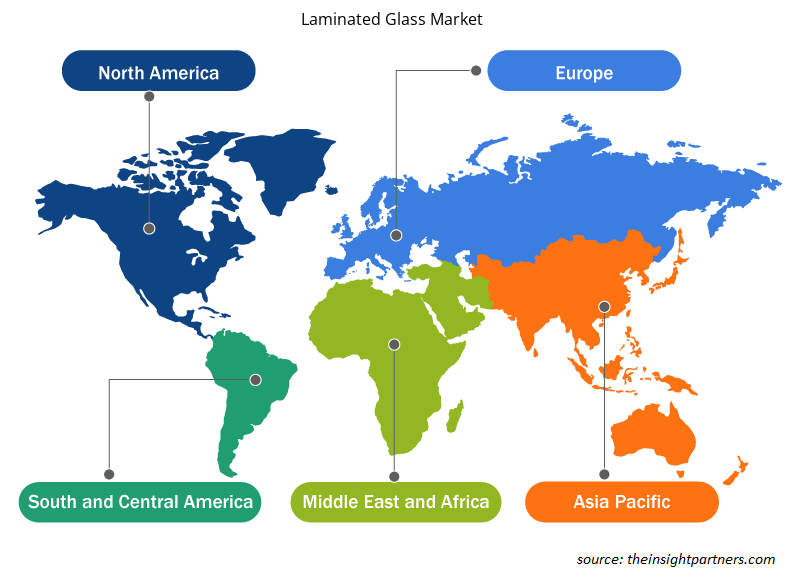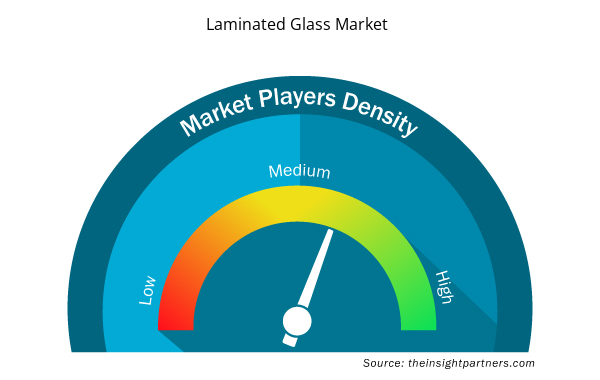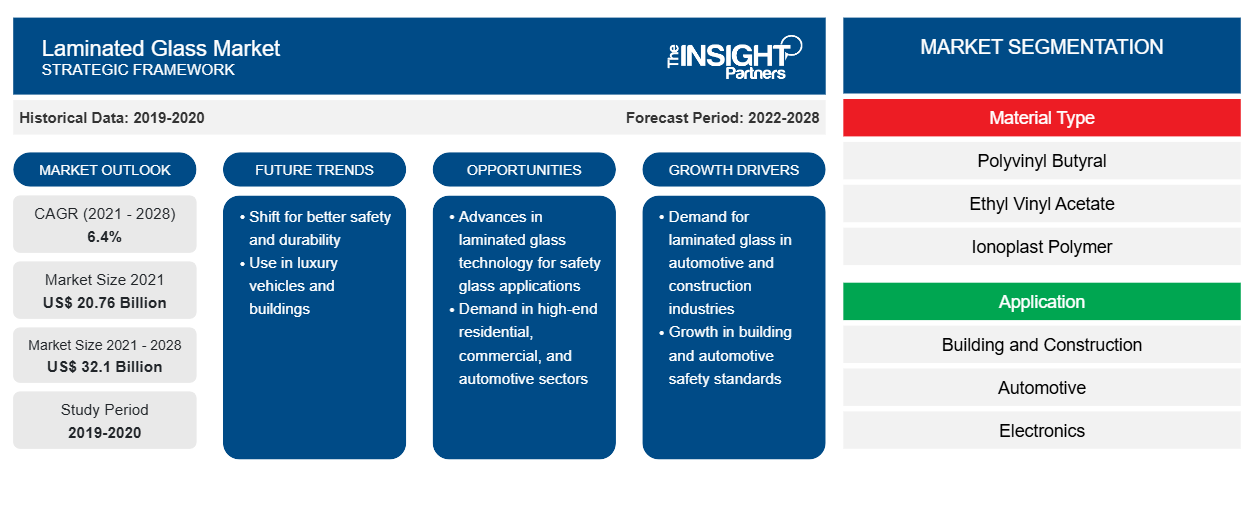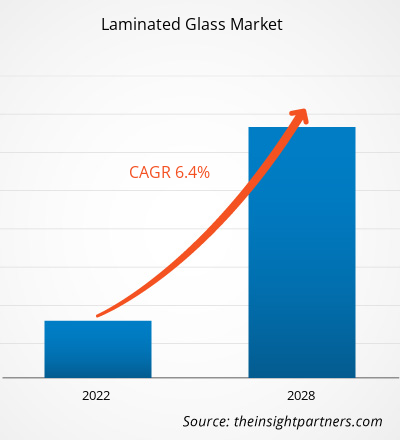Se proyecta que el mercado de vidrio laminado alcance los 32.100 millones de dólares en 2028 desde los 20.760 millones de dólares en 2021 y se espera que crezca a una CAGR del 6,4 % entre 2021 y 2028.
El vidrio laminado se prepara aplicando presión y calor a varias capas de vidrio templado o reforzado con calor. El vidrio laminado está separado por una capa intermedia que ayuda a mantener unidos los fragmentos de vidrio cuando reciben un impacto. El vidrio tiene amplias aplicaciones en industrias como la construcción, la automoción y la electrónica.
En 2020, Asia Pacífico tuvo la mayor participación en los ingresos del mercado mundial de vidrio laminado . El creciente número de proyectos de construcción residencial y comercial es el principal factor que contribuye al crecimiento del mercado en esta región. El consiguiente crecimiento de la industria de la construcción está impulsando la demanda de vidrio laminado en la región. Además, Asia Pacífico tiene una industria automotriz dominante y registra la mayor producción de vehículos entre todas las regiones. El vidrio laminado se usa ampliamente en cubiertas de parabrisas en la industria automotriz, lo que crea oportunidades comerciales favorables para los fabricantes de vidrio laminado.
Personalice este informe según sus necesidades
Obtendrá personalización en cualquier informe, sin cargo, incluidas partes de este informe o análisis a nivel de país, paquete de datos de Excel, así como también grandes ofertas y descuentos para empresas emergentes y universidades.
- Obtenga las principales tendencias clave del mercado de este informe.Esta muestra GRATUITA incluirá análisis de datos, desde tendencias del mercado hasta estimaciones y pronósticos.
Impacto de la pandemia de COVID-19 en el mercado del vidrio laminado
La pandemia de COVID-19 ha afectado a las economías e industrias de varios países debido a los confinamientos, las prohibiciones de viaje y los cierres de empresas. La industria química y de materiales fue una de las principales industrias que sufrió graves consecuencias, como interrupciones en las cadenas de suministro y cierres de plantas de producción. Se espera que la escasez del mercado del vidrio laminado dure hasta 2021, lo que provocará interrupciones en varias empresas. Además, muchas fábricas y fabricantes tuvieron que suspender o ralentizar la producción de vidrio, lo que hizo que fuera extremadamente difícil satisfacer las demandas actuales. La industria de la construcción ha sido la principal víctima de la escasez de vidrio. Durante el cierre, los residentes invirtieron tiempo y dinero en reconstruir o remodelar sus hogares, lo que impulsó la demanda de materiales. Además, debido a las dificultades para adquirir vidrio, el negocio del vidrio laminado ha sufrido un revés significativo. Por lo tanto, la baja demanda de las industrias de usuarios finales durante la pandemia de COVID-19 ha provocado una desaceleración del crecimiento del mercado del vidrio laminado.
Perspectivas del mercado
La creciente aplicación en la industria de la construcción impulsa el crecimiento del mercado del vidrio laminado
La demanda de vidrio laminado en la industria de la construcción ha ganado un impulso significativo debido al creciente uso del vidrio como elemento estructural y la preferencia por diseños arquitectónicos más creativos. El uso del vidrio como elemento estructural en proyectos de construcción convencionales se está volviendo más popular. El vidrio laminado se usa ampliamente en diversas aplicaciones interiores y exteriores en la industria de la construcción. Además, aumenta la seguridad y durabilidad de los diseños modernos. La necesidad de mantener seguros los hogares y los edificios comerciales ha impulsado la demanda de vidrio de seguridad y otros productos de acristalamiento.
Información sobre aplicaciones
Según la aplicación, el mercado mundial de vidrio laminado se segmenta en edificación y construcción, automoción, electrónica, paneles solares y otros. El segmento de edificación y construcción tuvo la mayor participación del mercado en 2020. El vidrio laminado se usa ampliamente en edificios residenciales y comerciales debido a su resistencia y naturaleza irrompible. El vidrio laminado se usa cada vez más en hoteles, terminales de aeropuertos y estudios de grabación debido a sus propiedades de aislamiento acústico. Es probable que el crecimiento de la industria de la edificación y construcción, especialmente en regiones emergentes como Asia-Pacífico, impulse la demanda de vidrio laminado en los próximos años.
Entre los actores clave del mercado mundial de vidrio laminado se encuentran Asahi India Glass Limited; Cardinal Glass Industries, Inc.; Central Glass Co., Ltd.; Fuyao Group; Guardian Glass Llc; Press Glass Sa; Saint Gobain SA; Schott Ag; Taiwan Glass Group; y Xinyi Glass Holdings Limited. Los actores que operan en el mercado están muy centrados en el desarrollo de ofertas de productos innovadores y de alta calidad para satisfacer los requisitos de los clientes.
Informe Destacado
- Tendencias progresivas de la industria en el mercado del vidrio laminado para ayudar a los actores a desarrollar estrategias efectivas a largo plazo
- Estrategias de crecimiento empresarial adoptadas por los mercados desarrollados y en desarrollo
- Análisis cuantitativo del mercado de vidrio laminado de 2019 a 2028
- Estimación de la demanda mundial de vidrio laminado
- Análisis de las cinco fuerzas de Porter para ilustrar la eficacia de los compradores y proveedores que operan en la industria
- Avances recientes para comprender el escenario competitivo del mercado
- Tendencias y perspectivas del mercado, así como factores que impulsan y restringen el crecimiento del mercado del vidrio laminado
- Asistencia en el proceso de toma de decisiones destacando las estrategias de mercado que sustentan el interés comercial y conducen al crecimiento del mercado.
- El tamaño del mercado de vidrio laminado en varios nodos
- Descripción detallada y segmentación del mercado, así como la dinámica de la industria del vidrio laminado.
- Tamaño del mercado de vidrio laminado en varias regiones con prometedoras oportunidades de crecimiento
Perspectivas regionales del mercado del vidrio laminado
Los analistas de Insight Partners explicaron en detalle las tendencias y los factores regionales que influyen en el mercado del vidrio laminado durante el período de pronóstico. Esta sección también analiza los segmentos y la geografía del mercado del vidrio laminado en América del Norte, Europa, Asia Pacífico, Oriente Medio y África, y América del Sur y Central.

- Obtenga datos regionales específicos para el mercado de vidrio laminado
Alcance del informe de mercado de vidrio laminado
| Atributo del informe | Detalles |
|---|---|
| Tamaño del mercado en 2021 | US$ 20,76 mil millones |
| Tamaño del mercado en 2028 | US$ 32,1 mil millones |
| CAGR global (2021-2028) | 6,4% |
| Datos históricos | 2019-2020 |
| Período de pronóstico | 2022-2028 |
| Segmentos cubiertos | Por tipo de material
|
| Regiones y países cubiertos | América del norte
|
| Líderes del mercado y perfiles de empresas clave |
|
Densidad de actores del mercado: comprensión de su impacto en la dinámica empresarial
El mercado del vidrio laminado está creciendo rápidamente, impulsado por la creciente demanda de los usuarios finales debido a factores como la evolución de las preferencias de los consumidores, los avances tecnológicos y una mayor conciencia de los beneficios del producto. A medida que aumenta la demanda, las empresas amplían sus ofertas, innovan para satisfacer las necesidades de los consumidores y aprovechan las tendencias emergentes, lo que impulsa aún más el crecimiento del mercado.
La densidad de actores del mercado se refiere a la distribución de las empresas o firmas que operan dentro de un mercado o industria en particular. Indica cuántos competidores (actores del mercado) están presentes en un espacio de mercado determinado en relación con su tamaño o valor total de mercado.
Las principales empresas que operan en el mercado del vidrio laminado son:
- Vidrio Asahi India Limitada
- INDUSTRIAS DE VIDRIO CARDINAL, INC.
- Compañía Central de Vidrio, Ltd.
- Grupo Fuyao
- VIDRIO GUARDIÁN LLC.
Descargo de responsabilidad : Las empresas enumeradas anteriormente no están clasificadas en ningún orden particular.

- Obtenga una descripción general de los principales actores clave del mercado de vidrio laminado
Segmentación del mercado de vidrio laminado:
Tipo de material
- Butiral de polivinilo
- Acetato de vinilo etílico
- Polímero ionoplástico
- TPU alifático
- Otros
Solicitud
- Construcción y edificación
- Automotor
- Electrónica
- Paneles solares
- Otros
Perfiles de empresas
- Vidrio Asahi India Limitada
- Industrias de vidrio Cardinal, Inc.
- Compañía de vidrio central, Ltd.
- Grupo Fuyao
- Guardian Glass LLC
- Prensa de vidrio Sa
- Saint-Gobain SA
- Schott Ag
- Grupo de vidrio de Taiwán
- Compañía de vidrio Xinyi Holdings Limited.
- Análisis histórico (2 años), año base, pronóstico (7 años) con CAGR
- Análisis PEST y FODA
- Tamaño del mercado Valor/volumen: global, regional, nacional
- Industria y panorama competitivo
- Conjunto de datos de Excel



Report Coverage
Revenue forecast, Company Analysis, Industry landscape, Growth factors, and Trends

Segment Covered
This text is related
to segments covered.

Regional Scope
North America, Europe, Asia Pacific, Middle East & Africa, South & Central America

Country Scope
This text is related
to country scope.
Preguntas frecuentes
Increasing usage of laminated glass in building & construction industry along with associated advantages of laminated glass are the key factors driving the market growth over the forecast period. With the increasing use of glass as a structural element and the preference for more creative architecture designs, the demand for laminated glass in the building & construction industry has gained significant momentum. The laminated glass has various advantageous features which includes safety, security, reduced noise pollution, reduced emissions, UV control, durability, weather/natural disasters protection, and design versatility. Thus, growing prospectus in constructing modern buildings and structures coupled with its beneficial advantages drives the laminated glass market over the forecast period.
In 2020, China held the largest market share in the global laminated glass market. China is the world’s largest vehicle market across the globe, as per the International Trade Administration (ITA). The Chinese government has taken several initiatives for automobile manufacturers for augmenting the production capacity of the country to 35 million by 2025. The growing prospects of construction industry in China is further fueling the market growth. For instance, in 2019, the government of China had invested US$ 1.9 billion in 13 public housing projects. Thus, increasing construction activities and automotive production is anticipated to propel the laminated glass market in China in the coming years.
In 2020, the polyvinyl butyral (PVB) segment accounted for the largest market share. The growth of the segment is primarily attributed to its tough and ductile interlayers which makes it an excellent sound insulator. The PVB interlayer joins with both layers of the glass and holds it together to produce one strong and uniform layer. As the bond between the PVB sheet and the glass is a chemical bond, it does not shatter easily. Thus, wide scope application in automotive industry for windshields applications, PVB segment is augmenting the market growth.
On the basis of application, automotive segment is the fastest growing segment. Laminated glass is most widely used in car windshields in the automotive industry. It provides various advantageous features such as high strength, soundproofing, resistance to shattering, and security. As laminated glass does not shatter, it minimizes the risk of cuts and injuries and ensures the safety of the driver and passengers. Thus, growing adoption of laminated glass in the automotive industry is projected to drive the market growth over the forecast period.
The major players operating in the global laminated glass market are Asahi India Glass Limited, Cardinal Glass Industries, Central Glass Co., Ltd., Fuyao Group, Guardian Glass LLC, PRESS GLASS SA, Saint-Gobain, Schott AG, Taiwan Glass Ind. Corp, and Xinyi Glass Holdings Co., Ltd.
In 2020, Asia Pacific accounted for the largest share of the global laminated glass market. Rapid development in construction & automotive industry has propelled the demand of laminated glass in the region. In addition, growing investments by governments in infrastructural development projects such as airports, and public transit systems is driving the demand for laminated glass in Asia Pacific region.
Trends and growth analysis reports related to Chemicals and Materials : READ MORE..
The List of Companies - Laminated Glass Market
- Asahi India Glass Limited
- CARDINAL GLASS INDUSTRIES, INC
- Central Glass Co., Ltd
- Fuyao Group
- GUARDIAN GLASS LLC.
- PRESS GLASS SA
- SCHOTT AG
- SAINT GOBAIN S.A.
- Taiwan Glass Group
- Xinyi Glass Holdings Limited
The Insight Partners performs research in 4 major stages: Data Collection & Secondary Research, Primary Research, Data Analysis and Data Triangulation & Final Review.
- Data Collection and Secondary Research:
As a market research and consulting firm operating from a decade, we have published and advised several client across the globe. First step for any study will start with an assessment of currently available data and insights from existing reports. Further, historical and current market information is collected from Investor Presentations, Annual Reports, SEC Filings, etc., and other information related to company’s performance and market positioning are gathered from Paid Databases (Factiva, Hoovers, and Reuters) and various other publications available in public domain.
Several associations trade associates, technical forums, institutes, societies and organization are accessed to gain technical as well as market related insights through their publications such as research papers, blogs and press releases related to the studies are referred to get cues about the market. Further, white papers, journals, magazines, and other news articles published in last 3 years are scrutinized and analyzed to understand the current market trends.
- Primary Research:
The primarily interview analysis comprise of data obtained from industry participants interview and answers to survey questions gathered by in-house primary team.
For primary research, interviews are conducted with industry experts/CEOs/Marketing Managers/VPs/Subject Matter Experts from both demand and supply side to get a 360-degree view of the market. The primary team conducts several interviews based on the complexity of the markets to understand the various market trends and dynamics which makes research more credible and precise.
A typical research interview fulfils the following functions:
- Provides first-hand information on the market size, market trends, growth trends, competitive landscape, and outlook
- Validates and strengthens in-house secondary research findings
- Develops the analysis team’s expertise and market understanding
Primary research involves email interactions and telephone interviews for each market, category, segment, and sub-segment across geographies. The participants who typically take part in such a process include, but are not limited to:
- Industry participants: VPs, business development managers, market intelligence managers and national sales managers
- Outside experts: Valuation experts, research analysts and key opinion leaders specializing in the electronics and semiconductor industry.
Below is the breakup of our primary respondents by company, designation, and region:

Once we receive the confirmation from primary research sources or primary respondents, we finalize the base year market estimation and forecast the data as per the macroeconomic and microeconomic factors assessed during data collection.
- Data Analysis:
Once data is validated through both secondary as well as primary respondents, we finalize the market estimations by hypothesis formulation and factor analysis at regional and country level.
- Macro-Economic Factor Analysis:
We analyse macroeconomic indicators such the gross domestic product (GDP), increase in the demand for goods and services across industries, technological advancement, regional economic growth, governmental policies, the influence of COVID-19, PEST analysis, and other aspects. This analysis aids in setting benchmarks for various nations/regions and approximating market splits. Additionally, the general trend of the aforementioned components aid in determining the market's development possibilities.
- Country Level Data:
Various factors that are especially aligned to the country are taken into account to determine the market size for a certain area and country, including the presence of vendors, such as headquarters and offices, the country's GDP, demand patterns, and industry growth. To comprehend the market dynamics for the nation, a number of growth variables, inhibitors, application areas, and current market trends are researched. The aforementioned elements aid in determining the country's overall market's growth potential.
- Company Profile:
The “Table of Contents” is formulated by listing and analyzing more than 25 - 30 companies operating in the market ecosystem across geographies. However, we profile only 10 companies as a standard practice in our syndicate reports. These 10 companies comprise leading, emerging, and regional players. Nonetheless, our analysis is not restricted to the 10 listed companies, we also analyze other companies present in the market to develop a holistic view and understand the prevailing trends. The “Company Profiles” section in the report covers key facts, business description, products & services, financial information, SWOT analysis, and key developments. The financial information presented is extracted from the annual reports and official documents of the publicly listed companies. Upon collecting the information for the sections of respective companies, we verify them via various primary sources and then compile the data in respective company profiles. The company level information helps us in deriving the base number as well as in forecasting the market size.
- Developing Base Number:
Aggregation of sales statistics (2020-2022) and macro-economic factor, and other secondary and primary research insights are utilized to arrive at base number and related market shares for 2022. The data gaps are identified in this step and relevant market data is analyzed, collected from paid primary interviews or databases. On finalizing the base year market size, forecasts are developed on the basis of macro-economic, industry and market growth factors and company level analysis.
- Data Triangulation and Final Review:
The market findings and base year market size calculations are validated from supply as well as demand side. Demand side validations are based on macro-economic factor analysis and benchmarks for respective regions and countries. In case of supply side validations, revenues of major companies are estimated (in case not available) based on industry benchmark, approximate number of employees, product portfolio, and primary interviews revenues are gathered. Further revenue from target product/service segment is assessed to avoid overshooting of market statistics. In case of heavy deviations between supply and demand side values, all thes steps are repeated to achieve synchronization.
We follow an iterative model, wherein we share our research findings with Subject Matter Experts (SME’s) and Key Opinion Leaders (KOLs) until consensus view of the market is not formulated – this model negates any drastic deviation in the opinions of experts. Only validated and universally acceptable research findings are quoted in our reports.
We have important check points that we use to validate our research findings – which we call – data triangulation, where we validate the information, we generate from secondary sources with primary interviews and then we re-validate with our internal data bases and Subject matter experts. This comprehensive model enables us to deliver high quality, reliable data in shortest possible time.


 Obtenga una muestra gratuita de este informe
Obtenga una muestra gratuita de este informe